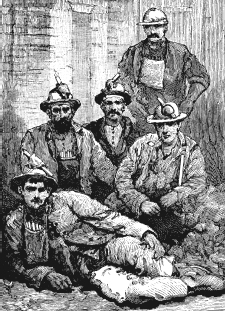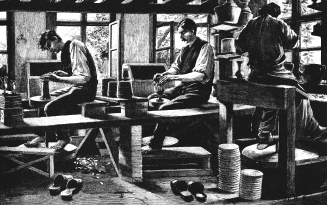
8
INDUSTRY & POPULATION
MINING
Tin mining in Devon began in Roman times, mostly on Dartmoor. In the eighteenth century the area was the major European source of the metal. Stannary towns included Plympton, Chagford, Tavistock and Ashburton. The county’s stannary department met at Crockern Tor, Dartmoor.

In Victorian times, after the discovery of a copper lode at Morwellham in 1844, Devon Great Consols (DGC), near Tavistock, including the mines of Wheal Maria, Wheal Fanny, Wheal Anna Maria, Wheal Josiah, Wheal Emma, Wheal Frementor, Watson’s Mine and Frementor, was the largest copper mine in the world. Production of copper reached a peak in 1862, with 41,513 tons produced. The area was also rich in arsenic and lead. By the end of the century deposits were exhausted, and DGC closed in May 1901.
In Hemerdon tungsten and tin were discovered in 1867, but it was last worked in 1944, though in 2007 plans were announced to reopen the mine. The last iron mine worked in Devon was Great Rock Mine, near Bovey Tracey, which closed in 1969, and the last remaining grante quarry, at Merrivale, closed in 1997.
LOCAL POTTERY
The Aller Vale Pottery was founded in 1865 in the hamlet of Aller, near Kingskerswell. It was taken over in 1868 by John Phillips (1835–97), a clay merchant from Newton Abbot, and after a period specialising in builders’ earthenware, including drainpipes, chimney pots and roof tiles, it began producing art pottery in 1881 when it was renamed the Aller Vale Art Pottery. After Phillips died, it was acquired by Hexter Humpherson & Co., who amalgamated it with another company they had recently acquired, Watcombe Pottery, to form Royal Aller Vale & Watcombe Co. Simplified to ‘Royal Watcombe’, it continued making mottoware for the tourist market until it closed in 1962.

Honiton earthenware pottery, mainly Jacobean in design, established in 1918, was largely the work of Charles Collard, who had formerly worked at the Aller Vale Pottery, Kingskerswell, and at the Crown Dorset Art Pottery, Poole. The company had its heyday in the 1930s, with Collard’s daughter Joan as the chief decorator and host to visitors who called in at the works. He retired due partly to failing eyesight in 1947 and sold the company. It ceased trading in 1997 and the name was sold to Dartmouth Pottery, established in 1947.
PHILATELY
The internationally famous firm specialising in what was for a long time regarded as the most popular hobby of all, Stanley Gibbons Ltd, had its origins in Plymouth. Stanley Gibbons (1840–1913) began selling postage stamps to collectors from a desk in the corner of his father’s pharmacy. When his father died in 1867 he took over the business, trading as a chemist and stamp dealer, selling the pharmaceutical side and relocating to larger premises in 1872, moving to London two years later. Married five times, he outlived four of his wives, leaving no children, and it is said that although still married to the fifth Mrs Gibbons, he died in the arms of a mistress at the Savoy Hotel, and to avoid scandal his body was concealed in a carpet and quietly removed to his nephew’s home nearby. The premature deaths of his first four wives has led to speculation that his training in the family business of chemistry may have enabled him to become a secret serial killer.
POPULATION
In Elizabethan times, Devon was said to be the second most populous county in England, after Yorkshire. After the census was introduced, records showed that between 1801 and 1831 she was fourth in the table, but had fallen to ninth by 1881, and fifteenth by 1951.
DEVON’S TOP 20 CITIES & TOWNS BY POPULATION
Figures taken from the 2001 census returns.
1. |
Plymouth |
240,720 |
2. |
Exeter |
111,076 |
3. |
Torquay |
63,998 |
4. |
Paignton |
48,251 |
5. |
Exmouth |
32,972 |
6. |
Newton Abbot |
23,550 |
7. |
Barnstaple |
20,724 |
8. |
Tiverton |
18,621 |
9. |
Brixham |
17,457 |
10. |
Teignmouth |
14,413 |
11. |
Bideford |
14,407 |
12. |
Sidmouth |
14,407 |
13. |
Dawlish |
13,135 |
14. |
Ivybridge |
12,056 |
15. |
Northam |
11,604 |
16. |
Tavistock |
11,018 |
17. |
Honiton |
10,857 |
18. |
Ilfracombe |
10,840 |
19. |
Kingsteignton |
10,615 |
20. |
Cullompton |
7,609 |
DEVON’S MEDIEVAL TOP FIVE
According to a survey of 1523 of all laypersons whose real estate amounted to £40 per year or more, the following were the wealthiest towns in Devon.
1.Exeter
2.Totnes
3.Plymouth
4.Colyton
5.Tavistock
PLYMOUTH’S POPULATION THROUGH THE AGES
In 1377, the Subsidy Roll of laypersons aged fourteen and over in Plymouth who were eligible to pay the poll tax was 4,837, suggesting a total population of about 7,000. Roughly the same figure is estimated for around 1600, the lack of increase being ascribed to the prevalence of disease and also frequent attacks by the French, which led some people to move inland. In 1733, the number of people in Plymouth Dock (which became Devonport in 1824) was estimated at 3,361, and in Plymouth 8,400.
The following figures are taken from the census returns for Plymouth. Up to and including 1911 there were separate figures for each of the three towns, Plymouth, Devonport and Stonehouse. Between 1801 and 1831 Devonport was the most populous of all three, with this position being reversed from 1841 onwards, and Stonehouse always being the smallest by a considerable margin. Owing to the Second World War there was no 1941 census, and as the 1951 figure shows, the figure had fallen substantially as a result of the exodus from the city during wartime and many not returning in peacetime.
1921 |
210,036 |
1931 |
227,631 |
1951 |
208,985 |
1961 |
231,505 |
1971 |
239,452 |
1981 |
243,895 |
1991 |
243,373 |
2001 |
240,720 |
At the time of writing, the latest figure available (November 2010) is 256,700, showing a significant increase on the falls since 1981.
EXETER’S POPULATION THROUGH THE AGES
1801 |
17,412 |
1811 |
18,896 |
1821 |
23,479 |
1831 |
28,242 |
1841 |
30,712 |
1851 |
32,823 |
1861 |
33,738 |
1871 |
34,650 |
1881 |
37,665 |
1891 |
37,404 |
1901 |
47,185 |
1911 |
48,664 |
1921 |
59,582 |
1931 |
67,607 |
1951 |
75,513 |
1961 |
88,598 |
1971 |
99,515 |
1981 |
95,621 |
1991 |
98,125 |
2001 |
111,078 |